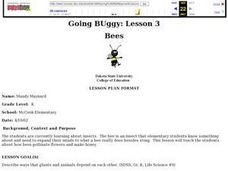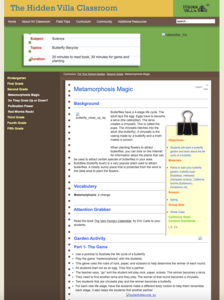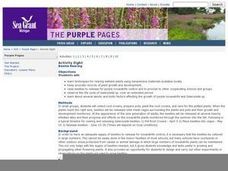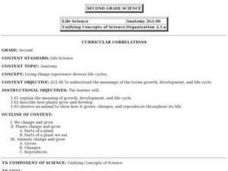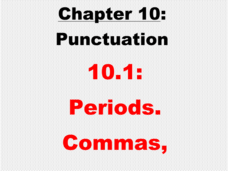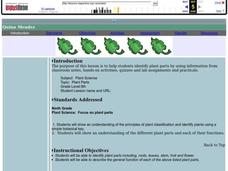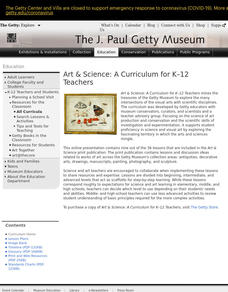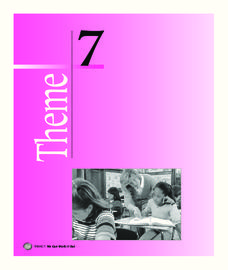Curated OER
Going Buggy: Lesson 3: Bees
Students review the characteristics of insects they have already been introduced to. As a class, they are introduced to the characteristics of bees and what it can do instead of sting. To end the lesson, they discuss how plants and...
Curated OER
Metamorphosis Magic
Students play rock-paper-scissors and create a play to demonstrate the butterfly life cycle. In this butterfly life cycle lesson plan, students also plant a butterfly garden with plants that attract butterflies.
Curated OER
Growing Garden Companions.
Students understand that some plants grow better with other plants. In this companion planting lesson, students observe the "three sisters" growing system used by the Native Americans. Students understand that small gardens grow better...
Curated OER
Beetle Rearing
Students investigate plants and the effects beetles have on the plants. In small groups, they collect plants and observe the beetles as they interact with the plants. They record the conditions including temperature, cloudiness, length...
Curated OER
Prairie Adaptations
Twelfth graders consider the survival of prairie plants. They examine how some tallgrass prairie species are adapted to the conditions of their ecosystem. They make a prediction of how a species might change given new conditions.
Curated OER
Rainforest Plant or Animal?
Young scholars explore the major functions of plants and animals. In this rainforest lesson plan students create a Venn diagram to compare and contrast animals in the rainforest.
Curated OER
Living Things Experience Diverse Life Cycles
Second graders will study and explain the meaning of growth, development, and life cycle. They describe how plants grow and develop and observe an animal to show how it grows, changes, and reproduces throughout its life.
Curated OER
Asexual Reproduction
Presented clearly and accurately, this PowerPoint introduces biology learners to asexual reproduction in plants. It begins by comparing asexual to sexual reproduction by definition and by the pros and cons of each. The remaining slides...
Curated OER
The Japanese Garden
High schoolers use the internet to gather information on the Japanese Gardens. They discuss topics with a horticulturist and build a replica of the gardens at their school. They work together to identify different types of plants.
Curated OER
Georgia CRCT Online
Prepare your class for a standardized exam with this language arts practice test. Designed for the Georgia Criterion-Referenced Competency Test (CRCT), these fifteen questions would be a great review for your seventh graders. Two...
Curated OER
Renewable vs. Non-Renewable Resources
Here's a fine lesson plan on renewable and non-renewable sources of energy for your 5th graders. In it, learners list a number of natural resources on the board, then try to sort the resources into appropriate categories. This helps them...
Curated OER
Cause and Effect Worksheet 2
Why does Scout fear Boo? Why does George kill Lennie? Whether in literature or life, helping young learners recognize the relationship between actions and consequences is an important lesson. Have your class match twelve observable...
Curated OER
How to Grow a Sunflower Plant
Students explore botany by conducting a sunflower growth experiment. In this plant life lesson, students identify the anatomy of a sunflower plant and the essential nutrients it requires to grow. Students utilize compost, soil, garden...
Curated OER
Punctuation: Periods. Commas,
Color-coded slides model for viewers the various uses of the comma and the period. The rule is presented and followed by several examples. Consider extending the lesson with a practice exercise.
Curated OER
Generate Measurement Data Word Problems
Plot data for three word problems, each with a table of data. Learners create line plots for these, all of which have only single-digit whole numbers. The large text and few number of problems make this ideal as a whole-class warm up....
Curated OER
Plant Parts
Ninth graders identify plant parts by using different classification methods. In this plant lesson students observe and draw different types of leaves then classify them according to species.
Curated OER
Plants Reproduce and Grow in Various Ways
Third graders take a walk around the outside of the school and examine their clothing to see if they picked up any seeds while on their walk. They discuss how seeds travel and how a new plant thus can form. They then observe root...
Curated OER
Clearly Classified
Young scholars review the classification system for living organisms and apply it the classification of insects and flowers in the still life by Ambrosius Bosschaert. They create a chart classifying the animals and plants in the painting...
Curated OER
Flowers, Pods, and Seeds
Students gain an understanding of living organisms. the complete a plant growth data log to chart plant growth and to make observations, predictions, and personal reflections.
Houghton Mifflin Harcourt
We Can Work It Out: English Language Development Lessons (Theme 7)
Listen, look, speak, and move are the routine steps of the English language development lessons found in a We Can Work It Out themed unit. Language proficiency is reinforced through picture cards, poems, and grand discussions about...
Curated OER
Sorting Things Out
Written to examine seeds that grow in Kansas, you can adapt this lesson to anywhere you live. Learners sort a mixture of five different seeds to by any characteristic of their choice. When your budding scientists are exploring the life...
Forest Foundation
Forest Health
Young foresters examine the strategies, like prescribed burns and thinning, that are employed to ensure healthy forests.
Curated OER
Make a Dried Bouquet
Students examine how drying flowers was a popular hobby for Colonial women during the Colonial era in America. They read and discuss an instruction sheet, and create dried-flower bouquets that are hung upside down and tied with a string.
Curated OER
A Garden in the Mailbox
Students study seed catalogs to find information about plants and growing seasons. They write letters requesting a seed catalog after using online resources. They use them complete an associated worksheet and discuss zone maps for their...
